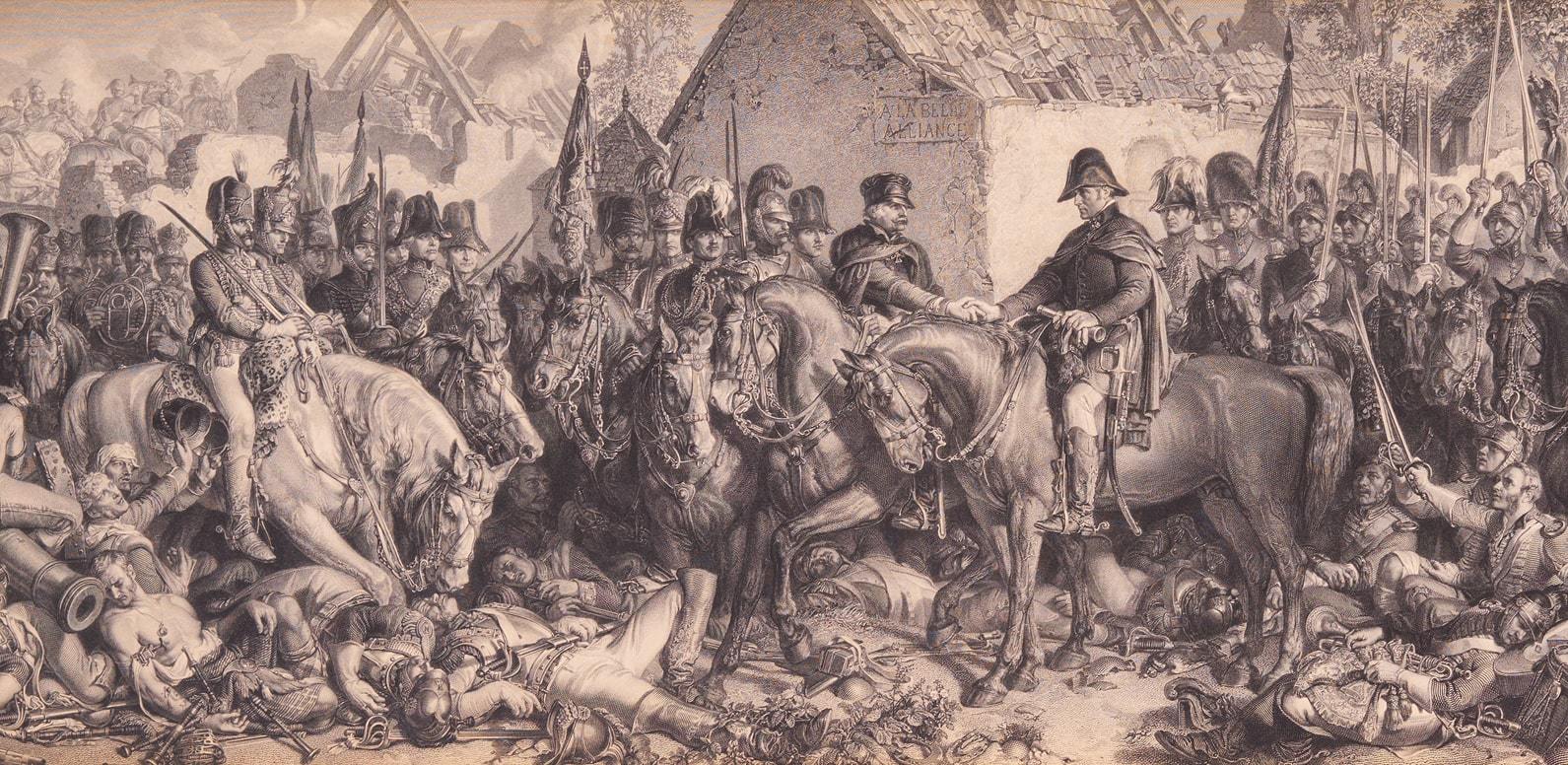War of the Sixth Coalition (1813-14)
Having defeated Austria once again in the War of the Fifth Coalition, Napoleon’s control over Europe seemed firmer than ever and it must have seemed as though the Napoleonic era would never end. In fact, the Napoleonic edifice was already showing signs of weakness. Not only had the Austrian army performed much better in 1809, but the Spanish and Portuguese, ably supported by their British allies, continued to resist the French armies in the Iberian Peninsula.
Meanwhile, Russia, having conquered Finland from Sweden, was beginning to distance herself from her alliance with Napoleon. The presence of a French client state in the Grand Duchy of Warsaw on Russia’s borders made the Russians uneasy. Meanwhile, the Continental Blockade deprived Russia of its lucrative trade with the British and Tsar Alexander began to allow the British vessels to trade in St Petersburg flying neutral flags. By 1810 Russia began planning for a resumption of hostilities, which finally came with the famous campaign of 1812.
The tale of Napoleon’s defeat is one of the most dramatic of the Napoleonic era, but will be told at a later time. Napoleon had persuaded his Austrian and Prussian allies to contribute some of their manpower for the invasion of Russia, but both powers sent contingents of 30,000 men each with great reluctance. Once the tables had turned, Prussia was the first to abandon ship. In February 1813, the Prussians signed the Treaty of Kalisz with Russia and joined Britain and Sweden in the Sixth Coalition.
The allied Russo-Prussian army under the command of Mikhail Kutuzov made steady progress westwards across Poland and northern Germany, capturing key fortresses on the way. Meanwhile Napoleon hurried back from Paris with new recruits and a handful of veterans from Spain. In April Kutuzov died from illness and was replaced as commander-in-chief by General Pyotr Wittgenstein. Wittgenstein’s relative lack of experience became clear as the allies were defeated at Lützen and Bautzen, but Napoleon himself suffered considerable losses and failed to consolidate on these victories.
Realising he was not Napoleon’s equal, Wittgenstein relinquished his command to General Mikhail Barclay de Tolly. While lacking Napoleon’s tactical imagination, Barclay had been instrumental in devising and implementing the strategic retreat in 1812 which frustrated Napoleon’s attempts to annihilate the Russian army. Thus, he was the only surviving Russian general who had any claim of being a worthy adversary for Napoleon.
Meanwhile, the allies sought to invite Austria into the Sixth Coalition. While Austria was a traditional enemy of France and had suffered four defeats at Napoleon’s hands, in 1810 the Austrian and French imperial houses were bound by marital ties as Francis’s daughter married Napoleon and became Empress Marie Louise. In June Emperor Francis sent his Foreign Minister Klemens von Metternich to mediate, and a two month armistice was declared, but Napoleon was unwilling to accept the terms offered. Thus, in August the Austrians reluctantly joined the Sixth Coalition. In a diplomatic gesture, Tsar Alexander, celebrated as the ‘liberator of Europe,’ offered the role of commander-in-chief to Austrian Field Marshal Karl von Schwarzenberg.
For the first time in the Napoleonic era, Austrian, Russian and Prussian troops were fighting together against the Grande Armée. The allies worked together to devise a strategic plan to win the war. Known as the Trachenberg Plan, it was agreed by Tsar Alexander, King Frederick William, Crown Prince Karl Johan of Sweden – who earlier in his life had been Marshal Jean Bernadotte – together with the Austrian Chief of Staff General Joseph von Radetzky. The Prussian chief of staff General Gerhard von Scharnhorst – who had died from his wounds at the end of June while negotiating with Metternich – is said to have suggested some of the key ideas during his meeting with the Austrian minister. The plan involved dividing the allied forces into three armies, each of which would avoid battle with Napoleon himself but seek to engage his marshals in battle before eventually trapping him with overwhelming numbers. Crucially, each army included troops from at least two nations in order to promote cohesion among the Sixth Coalition. While this did not stop the bitter infighting at headquarters, the allies were sufficiently united by the common cause to carry on the fight.
And so it was that three allied armies – the Army of Bohemia commanded by Schwarzenberg (220,000 men), the Army of Silesia (95,000) under the charismatic Prussian Gebhard von Blücher, and the Army of the North (120,000) under Bernadotte – closed in on Napoleon’s position in central Germany. Despite the lengthening odds, Napoleon managed to achieve victory over the Army of Bohemia at Dresden on 26-27 August. However, he lacked the sufficient cavalry to consolidate on the victory and a few days later General Vandamme’s corps was defeated at Kulm while pursuing the allies. Meanwhile, Blücher and Bernadotte were both on the march. The allies kept the initiative and the three armies converged on Napoleon at Leipzig. The ensuing four day battle between 15 and 19 November 1813 – also called the Battle of the Nations – was the largest until the First World War. The momentum of the battle shifted back and forth, and Napoleon’s defeat was not pre-ordained, but the allied numbers eventually prevailed.
The momentum enjoyed by the allies following victory at Leipzig carried the Sixth Coalition armies into northeastern France by late 1813, just as the Duke of Wellington’s army began to push over the Pyrenees into French territory from the southwest. By this point Napoleon had fewer than 100,000 men to defend the northeast. With his back against the wall and 20-30,000 men with him, Napoleon won a series of victories over the much larger Army of Silesia in February 1814, rediscovering some of his youthful vigour in the process. It was not to last – rather than chasing after Napoleon, the allies decided to send a force to capture Paris, and the city fell on 31 March.
With Napoleon absent from Paris, the French Senate agreed to the allied demands to depose the emperor. When Napoleon attempted to march on Paris, his marshals refused and mutinied. The general who had won the imperial crown through military conquest was now left without his army and had no alternative but to abdicate. The allies restored Louis XVIII, the younger brother of the executed Louis XVI, as King of France. Napoleon was allowed to keep his imperial title and was exiled to the island of Elba off the coast of Tuscany. On a bright day, he could see his native Corsica some thirty miles to the west. The allies hoped that they would hear no more of Napoleon, and made their way to Vienna to negotiate a peace settlement for the European continent, which had experienced so much war over the course of the Napoleonic era.
War of the Seventh Coalition/Hundred Days Campaign (1815)
The trials and tribulations of the Congress of Vienna, which brought together Austria, Russia, Prussia, Britain – as well as Bourbon France – to negotiate a post-Napoleonic European settlement, is far too complicated to go into here. Needless to say, once Napoleon was defeated and the allies sat down on the negotiating table, the common cause melted away and the negotiators once again prioritised their national interests above all else – playing an elaborate game of musical chairs in the Viennese salons and bedchambers. The unity among the erstwhile Quadruple Alliance of Austria, Britain, Prussia and Russia was only restored when news reached Vienna that Napoleon was back.
On 26 February 1815, Napoleon escaped from Elba and landed in France on 1 March. This was not the first time he managed to evade the Royal Navy – he had done so when he escaped from Egypt in 1799. Although he was accompanied by only some 1,000 men that he had been allowed to retain as a personal guard in Elba, he was welcomed almost everywhere he went and many of his veterans – overcome with nostalgia – soon joined his ranks. Marshal Michel Ney, who had promised King Louis XVI to bring Napoleon to Paris in an iron cage, was overwhelmed by emotion and defected to Napoleon’s side with his men. By 20 March, less than three weeks after his landing, Napoleon was once again in Paris and returned to the imperial throne.
The restored Quadruple Alliance was keen to get rid of Napoleon once and for all. The four powers each agreed to contribute an army of 150,000 men to the cause. The British under the Duke of Wellington and the Prussians under Blücher would invade France from the north. Schwarzenberg’s Austrians and Barclay’s Russians would attack from the east through Germany. Including the minor powers, the allies would have up to a million men under arms threatening France from all directions. In contrast, Napoleon only had 200,000 men to defend France, though many were seasoned veterans. Napoleon decided that his best chance of victory lay in striking north and defeating the British and Prussians first before turning his attention eastwards. Napoleon organised 125,000 men into the Army of the North and marched to Belgium to confront Wellington and Blücher.
Napoleon divided his army into three corps. Marshal Ney on the left would take on Wellington, while Marshal Grouchy on the right would oppose the Prussians. Napoleon, in command of the central reserve corps, would strike in either direction depending on circumstances. On 16 June, Ney engaged Wellington at Quatre Bras while Grouchy fought the Prussians at Ligny. Napoleon joined Grouchy and defeated the Prussians. This forced Wellington to withdraw from Quatre Bras in order to maintain contract with the Prussians. Expecting the Prussians would retreat eastwards, Napoleon then joined Ney to hunt down Wellington, ordering Grouchy to keep the Prussians busy.
On the evening of 17 June, Wellington received notice from the Prussian General von Müffling, who informed him of Blücher’s intention to support him the following day. The British commander decided to deploy his army along the Mont Saint Jean ridge to the south of the village of Waterloo. Both armies had some 70,000 men in their ranks, but Napoleon’s were far more experienced. While he was able to draw on many of his veterans, the best British troops were engaged against the United States in the War of 1812. Less than half of Wellington’s men were British, the rest were German, Belgian and Dutch. Napoleon was confident of victory. As long as Grouchy could prevent the Prussians from joining the battle, he could defeat Wellington and live another day.
The Battle of Waterloo began on the morning of 18 June 1815. Napoleon delayed his assault on Wellington’s position as heavy overnight rain prevented him from moving his artillery into position. Wellington had sent a few thousand men to garrison the farmhouses of Hougoumont, La Haye Sainte, and Papelotte in front of the ridge line, while keeping most of his forces behind to protect them against enemy artillery fire. Napoleon launched his assault on the farmhouses at around 9 o’clock. Even though Wellington had intended to withdraw his men after softening up the enemy’s attack, the fiercest fighting would take place in the struggle for Hougoumont and La Haye Sainte. The French eventually took the positions but at great cost.
By afternoon, the first Prussian units appeared on Napoleon’s right flank, while Grouchy was nowhere to be seen. Napoleon knew that he had to break through the British line before the Prussians arrived in large numbers. Wellington barely struggled to hold on, but the increasing number of Prussians on the field forced Napoleon to use up vital reserves. Marshal Ney desperately led two cavalry charges which were beaten back by the British infantry squares. In a last ditch effort, Napoleon ordered his Old Guard to advance, but even the introduction of some of the best soldiers in the world was not enough. The Guard fell back, and Wellington ordered a general advance. The French took flight, pursued by the British and Prussians. Napoleon had lost the Battle of Waterloo.
Napoleon intended once again to fight on after his defeat at Waterloo, but once again his generals saw that his cause was hopeless. The Napoleonic era had finally and definitively come to an end. Thus, on 22 June 1815 Napoleon abdicated for the second time. Knowing that the Prussians wanted to capture and execute him, he hurried to the Rochefort on the Atlantic coast in an effort to escape to America. The British were waiting for him and Napoleon had no option but to surrender onboard the HMS Bellerophon.
When the British refused his request to go to North America, he hoped that he might be allowed to live out his life as an English country gentleman. Sadly this was not to be. After two weeks of deliberation, during which Bellerophon was anchored in Plymouth, the British authorities made their decision. Not wishing to repeat the mistake of Elba, the British government chose to send the former emperor to Saint Helena, a remote island in the South Atlantic thousands of miles from the nearest continental landmass. There would be no escape this time, and Napoleon died in Saint Helena on 5 May 1821.
Did you enjoy reading this article about Napoleon's demise? Check out this poster commemorating Wellington and Blücher's victory at the Battle of Waterloo.

This article is part of a three part series on the seven anti-French coalitions. Here are the other parts:



Share and get 15% off!
Simply share this product on one of the following social networks and you will unlock 15% off!